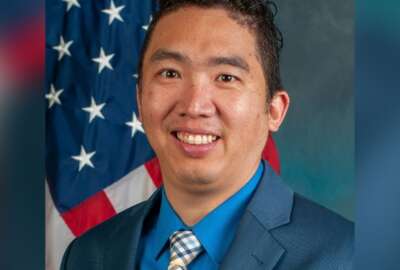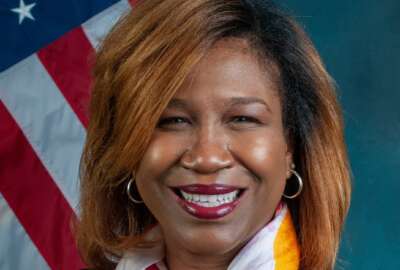Hubbard Radio Washington DC, LLC. All rights reserved. This website is not intended for users located within the European Economic Area.
GAO wants to see National Weather Service improve around leadership reforms
The National Weather Service, part of the Commerce Department, has been acting on a reform initiative since 2017. It's trying to become more responsive to extre...
Best listening experience is on Chrome, Firefox or Safari. Subscribe to Federal Drive’s daily audio interviews on Apple Podcasts or PodcastOne.
The National Weather Service, part of the Commerce Department, has been acting on a reform initiative since 2017. It’s trying to become more responsive to extreme weather events. And, the Government Accountability Office has found it has mostly done a good job at using best practices for reform. For more on what it still needs to do, the GAO’s Acting Director for Natural Resources and Environment Issues, Cardell Johnson spoke to Federal Drive with Tom Temin.
Interview transcript:
Tom Temin: Mr. Johnson, good to have you on.
Cardell Johnson: Thank you very much. It’s good to be here
Tom Temin: And outline for us precisely what they’re trying to do under this reform effort, automate their balloons, and what are they specifically trying to do here?
Cardell Johnson: Well, basically what they’re trying to do, the whole vision is to make the United States a weather ready nation where we are responsive and resilient to extreme weather events. So as you know or a lot of the readers probably know, extreme weather events have really become increasingly frequent and more destructive and costly. And so I think in the last about three decades, we’ve had 285 different extreme weather events. We’re talking like hurricanes and floods, tornadoes, and that’s come to about 1.8 trillion in economic damage and 14,000 lives. So the Weather Service, what they do is they provide forecasts and May issue warnings to people during extreme weather events. And so they thought to help protect life into protect property, they need to sort of evolve what they do to be able to make us prepare for these extreme weather events.
Tom Temin: And what form does some of that evolution take?
Cardell Johnson: Well, essentially, what they determine is to reform its workforce and operations, they set up about 20 different reform efforts. It’s anything from investing in their people and their workforce, making sure that the workforce has the skills and resources to be able to do what it needs to do and partner with local state emergency managers. But then also some of those reforms target updating technology, as well as different forecasting models that they use.
Tom Temin: Yeah, I was interested to find the issue 1.5 million forecasts and 50,000 warnings annually. So this is not just once a day there’s a new weather forecast. And you found that they mostly did follow the best practices for agency reform?
Cardell Johnson: Yeah, absolutely. So we assess their management of their reform efforts. So we didn’t really get into the technical quality aspect of each reform, more so how they’re managing it. And to do that, there are leading practices for effective perform that basically incorporates change management principles, because essentially what this is, is major change for the agency. And as you probably know, and your listeners know, change is just really hard. It can be emotional in sort of moving, how people react to it and sort of moving the organization from one state to another state.
Tom Temin: And you found that of the eight major best practices for reforming, they follow five of them fully, but the ones that they don’t follow seem significant. And those are establishing goals and outcomes, involving employees and key stakeholders, and leadership, focus and attention. And it seems like if those aren’t followed, the rest of it may not happen.
Cardell Johnson: Well, what we say is they are harshly following those. So each one of those leading practices have several different principles. So for example, on leadership, focus and attention, which is probably where they really need to focus their efforts, that’s about establishing a leader or a leadership team to oversee the reforms. It’s also developing and articulating a compelling message for the reforms, having an accountability system for the leader over the reforms and having a dedicated implementation team. And so when we were assessing how well they did against this best practice, we noticed that they did actually put a leadership team in place, and they have articulated a compelling reason for these reforms. But what they have not done is have that dedicated implementation team, that capacity and continuity just to ensure that they can see these reforms through.
Tom Temin: We’re speaking with Cardell Johnson, he’s acting director for natural resources and environment issues at the GAO. And should that leadership and that oversight extend upward from the National Weather Service to NOAA, its immediate superior agency and to the Commerce Department itself?
Cardell Johnson: Well, that wasn’t actually the focus of our review. However, what would extend up to NOAA is issues I think related to staffing. So one of the things that this was not the particular focus of this review, but goes back to a review we did in 2017. Some of the barriers to progress would be staffing, and we certainly heard those issues during the the course of this 2021 review. And so hiring is done centrally at NOAA, not at the National Weather Service level. So that’s where no one can get involved.
Tom Temin: All right, so there are some things they have to tighten up. What were your major recommendations?
Cardell Johnson: Well, so the major recommendations here is that they need to provide the leadership and staff continuity and capacity so that for the project management office that oversees the implementation of these reforms, just to ensure that they’ve got the resources, skills, and tools they need to see those reforms through. The other key recommendation that we’re making here is that the National Weather Service has to develop a two way communication strategy that will outline how it will listen and respond to employees concerns, because as I noted earlier, this is really about change. These are major reforms that are taking place, and employees have concerns about those reforms and how they may be impacted.
Tom Temin: Yes, because some of the, again, technical reforms are new algorithms for weather forecasting and new equipment, and so forth. So that would definitely affect how people work when this is eventually in place.
Cardell Johnson: Absolutely. And also the accuracy of some of the weather forecasting models. Some of the folks that we’ve met with said that they’re concerned about that accuracy. And the good thing here is that the National Weather Service has rolled out a platform to forecasters to sort of provide that input about these models. And so they’re actually working to tweak those to make them better. But the area where it seems that the National Weather Service really hasn’t done the best job in terms of engaging is on the sort of cultural change piece of this. So there are a lot of employees, they look at these reforms and they don’t disagree with overall sentiment or form. But I think, we all know the devils in the details. And so some of them see these reforms could lead to office closure and job losses, and those issues need to be addressed.
Tom Temin: And did the agency leadership generally agree with the recommendations? They haven’t acted on them yet, but did they agree with them?
Cardell Johnson: They did agree with the recommendations that we made, and they’re working on a corrective action plan to implement them.
Tom Temin: And does this reform effort, does it have an end date when they can stand up and say, well, we are reformed?
Cardell Johnson: Well, they do not have that yet. So part of what has impeded some progress is COVID. So they’ve had to sort of take a step back and reassess. But they are also moving to a next phase of the performs. And so right now, there’s no end date.
Tom Temin: Got it. And we should note that this is called the Evolve program. That’s the Weather Service’s name for what it is they’re undertaking.
Cardell Johnson: Yes, absolutely.
Tom Temin: So we need to wait and see than, and hopefully if they can get back together in person more, maybe some of this will accelerate — do you think?
Cardell Johnson: Perhaps. But we do know that they, I think for a lot of agencies, probably that first six to eight months of the pandemic was really hard, and people just adjusting to work life under extreme conditions. And so what it leaves our conversations with the National Weather Service, it does appear that folks are re-engaged in the discussions and they’re really trying to move this forward. And I think I was very encouraged from what I heard in the testimony before the House Space Science and Technology Committee last week that I testified, so they’re really working to try to bring these reforms home.
Tom Temin: Cardell Johnson is acting director for natural resources and environment issues at the Government Accountability Office. Thanks so much.
Cardell Johnson: Yeah, thank you, anytime.
Copyright © 2024 Federal News Network. All rights reserved. This website is not intended for users located within the European Economic Area.
Tom Temin
Tom Temin is host of the Federal Drive and has been providing insight on federal technology and management issues for more than 30 years.
Follow @tteminWFED
Related Stories
Related Stories
-
GAO has recommendations to safeguard integrity of federal R&D grants Agency Oversight





